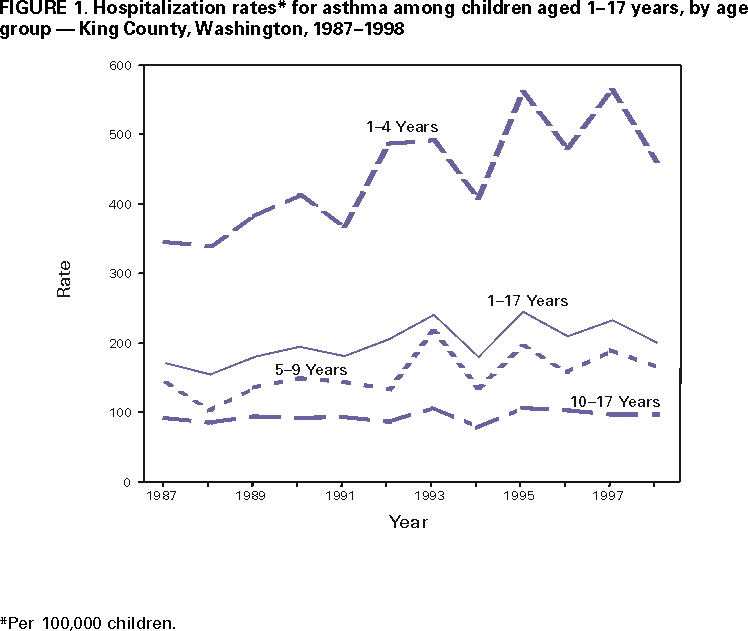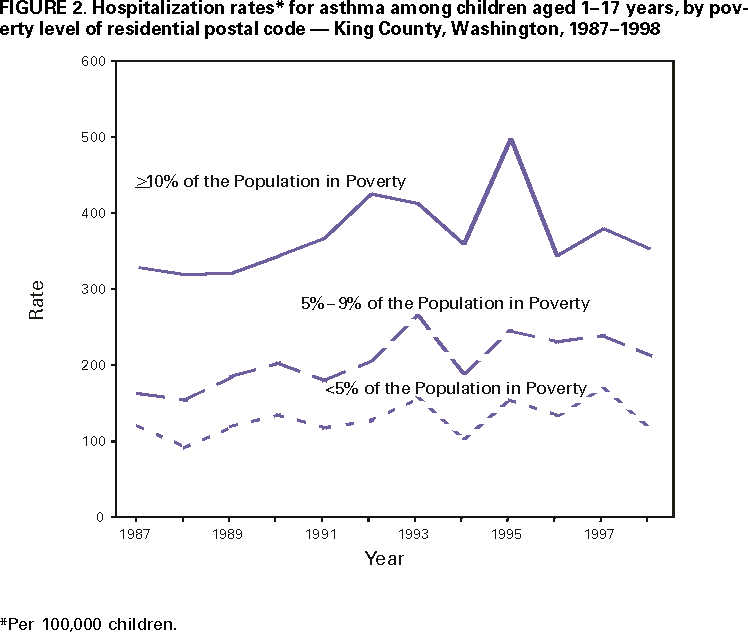 |
|
|
|
|
|
|
| ||||||||||
|
|
|
|
|
|
|
||||
| ||||||||||
|
|
|
|
|
Persons using assistive technology might not be able to fully access information in this file. For assistance, please send e-mail to: mmwrq@cdc.gov. Type 508 Accommodation and the title of the report in the subject line of e-mail. Childhood Asthma Hospitalizations --- King County, Washington, 1987--1998Since 1980, asthma prevalence, hospitalization, and mortality have been increasing in the United States (1). Because of concern about asthma morbidity in children in King County, Washington (2), Public Health--Seattle and King County (PH-SKC) conducted a study that analyzed trends in local hospitalizations for childhood asthma during 1987--1998. This report summarizes the results of this analysis, which indicate that the youngest children and the poorest communities have the highest rates of asthma hospitalization. Nonconfidential data on all hospital discharges among persons aged 1--17 years for 1987--1998 were obtained from the Washington State Department of Health. Asthma hospitalizations were those discharges with an International Classification of Disease-Clinical Modification (ICD-CM), Ninth Revision, code 493*. If a child had been hospitalized more than once during any year, each hospitalization was counted. Population estimates for the study were provided by the Washington State Department of Social and Health Services for intercensal years and the U.S. Census Bureau for 1990; study data were analyzed by poverty status, county health planning area (HPA), and age group (i.e., 1--4, 5--9, and 10--17 years). Using the postal code of residence and U.S. Census Bureau data, poverty status strata were <5%, 5%--9%, and >10% of the population living below the federal poverty level†. The 20 HPAs were defined by aggregating postal codes (3). Trends during 1987--1998 were evaluated with a chi-square test for trend (4). A simple chi-square was calculated using Epi Info 6.0 (5) to compare subpopulation rates and to adjust for multiple hospital admissions in certain children (6,7). Results were considered significant if p<0.05. Subpopulation comparisons were made using 1998 data; 3year average rates (1996--1998) were calculated to increase the stability of rates in HPAs with small populations. During 1987--1998 in King County, childhood asthma admissions increased 53% (from 505 to 772 children), and overall childhood hospitalization rates for asthma increased 17% (from 170 to 200 per 100,000 children) (p<0.001) (Figure 1). During this period, the rate for all nonbirth-related childhood hospitalizations decreased 28%, from 2689 to 1931 per 100,000 children. In 1998, for children aged 1--4 years, the hospitalization rate for asthma was 2.8 times higher than the rate for children aged 5--9 years (461 versus 164; p<0.001) and 4.8 times higher than the rate for children aged 10--17 years (97; p<0.001) (Figure 1). The hospitalization rate for children aged 5--9 years was 1.7 times higher than the rate for those aged 10--17 years (164 versus 97; p<0.001). During 1987--1998, the hospitalization rates for asthma increased 34% among children aged 1--4 years and 17% among children aged 5--9 years (Figure 1) (p<0.001); children aged 10--17 years showed no significant trend during this period. Hospitalization rates for asthma among children residing in areas where poverty was greatest were significantly higher than rates among children residing in other areas (Figure 2). In 1998, among children in the county's high-poverty areas, 353 per 100,000 asthma hospitalizations occurred, which was 1.7 times the rate in medium-poverty areas (212; p<0.001), and 3.0 times the rate for residents in areas with the lowest poverty (119; p<0.001). During 1987--1998, rates for the low-poverty and medium-poverty areas increased significantly (Figure 2) (p<0.01). Asthma-related hospitalization rates also increased significantly for the high-poverty areas during 1987--1995 (p=0.011) but decreased from 1995 to 1998 (p=0.008). During 1996--1998, hospitalization rates varied significantly among HPAs (p<0.001). The rates for central and southeast Seattle HPAs, adjacent to Seattle's urban center, were not significantly different from each other but were significantly different from the HPAs in the rest of the county. The rate in the aggregated central and southeast HPA area (512 per 100,000) was 2.7 times the rate in the rest of the county (191 per 100,000; p<0.001). The central and southeast Seattle HPA area also had the highest proportion of residents living below the poverty level (22% in central and southeast Seattle compared with 7% in the rest of the county) and the highest proportion of blacks (31% compared with 3%) and Asians/Pacific Islanders (28% compared with 9%). Reported by: D Solet, PhD, J Krieger, MD, Public Health--Seattle and King County, Seattle; J Stout, MD, L Lui, MD, Univ of Washington, Seattle. Air Pollution and Respiratory Health Br, Div of Environmental Hazards and Health Effects, National Center for Environmental Health, CDC. Editorial Note:The extent of asthma morbidity is estimated with various measures, including data from surveys, outpatient visits, hospital discharges, and emergency department visits. Local hospitalization data have the advantage of wide availability and the capacity for analysis by age groups, geographic regions and, in some states, race/ethnicity. Hospital discharge rates also may be a persuasive measure for communities seeking to reduce the burden of asthma. The reasons for the increase in childhood asthma hospitalizations in King County are unclear; however, they may be related to an increased prevalence of asthma or increasing severity of asthma in this area. A higher rate of asthma hospitalizations in King County occurred among children residing in poor neighborhoods, although the risk has increased for all King County children. A recent analysis of asthma hospitalizations in New York City also found a correlation between low median family income and increased asthma hospitalization rates (8). The findings in this report are subject to at least five limitations. First, the analysis by neighborhood poverty level depended on postal code poverty levels reported from the 1990 U.S. census. If the poverty level of postal codes has changed, postal codes may have been assigned to a poverty category that did not reflect their current status. Second, poverty level was assigned ecologically and may not reflect a person's status. Third, geographic groupings were based on reported postal code. Because no other address data were available, erroneously reported postal codes may lead to misclassification by either poverty level or HPA. Fourth, race/ethnicity differences that may be independent of poverty status in asthma hospitalization may account for some findings (1). Finally, patients who received effective treatment in a primary-care setting may be less likely to be hospitalized, thus underestimating asthma severity and morbidity. The use of local hospitalization data has helped to mobilize institutional and community-based support and interventions and has directed them to areas of greatest need. In response to the asthma problem identified in this area, the King County Asthma Forum was created by PH-SKC and the American Lung Association of Washington to facilitate communication among community-based organizations about asthma prevention, diagnosis, and management. PH-SKC, the Master Home Environmentalist Program, the University of Washington, the Washington Toxics Coalition, and other partners have implemented Healthy Homes, an intervention and evaluation project whose goal is to reduce exposure to indoor asthma triggers among 300 low-income households of children with asthma (9). On the basis of data from this report, in central and southeast Seattle, PH-SKC has collaborated with a neighborhood pediatric clinic to fund the Asthma Outreach Project (10) that provides comprehensive case management for children with asthma. References
* Includes extrinsic, intrinsic, and unspecified asthma. † Poverty thresholds from the Bureau of the Census, Economics and Statistics Administration, U.S. Department of Commerce were used for this calculation. Figure 1  Return to top. Figure 2  Return to top. Disclaimer All MMWR HTML versions of articles are electronic conversions from ASCII text into HTML. This conversion may have resulted in character translation or format errors in the HTML version. Users should not rely on this HTML document, but are referred to the electronic PDF version and/or the original MMWR paper copy for the official text, figures, and tables. An original paper copy of this issue can be obtained from the Superintendent of Documents, U.S. Government Printing Office (GPO), Washington, DC 20402-9371; telephone: (202) 512-1800. Contact GPO for current prices. **Questions or messages regarding errors in formatting should be addressed to mmwrq@cdc.gov.Page converted: 10/19/2000 |
|||||||||
This page last reviewed 5/2/01
|